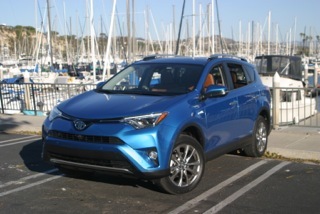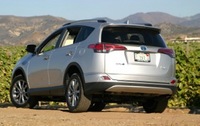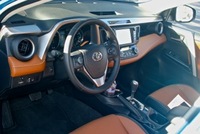2016 Toyota RAV4 Hybrid and RAV4 SE Review By Steve Purdy
 |
2016 TOYOTA RAV4 HYBRID AND SE
FIRST DRIVES
By Steve Purdy
Senior Editor
The Auto Channel
Michigan Bureau
As part of the recent mid-cycle refresh of the RAV4 compact crossover Toyota is now adding a hybrid version and a sporty new SE trim level. We’re in California this week for our first look and drive at these two new vehicles.
 |
The mileage numbers are impressive – 34 mpg in the city, 31 on the highway and 33 mpg combined using regular fuel. Those are not official yet – just expected by Toyota. The essence of this newest iteration of Toyota’s Synergy Drive is a 2.5-liter, Atkinson cycle, 4 cylinder boosted by a nickel-metal hydride battery pack making a total of 194 horsepower and 206 pound-feet of torque. Only the smart CVT (continuously variable transmission) is offered but it is the more civilize planetary gear type and has a manual mode with intelligence built in that will make it feel more like a conventional transmission under most circumstances. We’re told the hybrid powertrain makes the difference between a tepid 0-to-60 mph time of 9.0 seconds for the conventionally powered car and a slightly less tepid 8.1 seconds for the hybrid.
Towing capacity for the regular RAV4 is listed at 1,500 pounds, somewhat better than many comparable vehicles, and the Hybrid is rated at 1,750 pounds.
We’re always concerned about a hybrid automobile’s tendency to offer considerably less cargo or passenger area in order to accommodate the hybrid components. Not so much with the new RAV4 Hybrid. Total cargo capacity is not quite 3 cubic-feet less than the conventionally powered vehicle – from the latter’s 73.4 cubic-feet to the Hybrid’s 70.6. The conventional car has a flat floor with the rear seatbacks folded but the hybrid has a little incline because the extra batteries are hidden under the rear seat. To make for a smoother loading process the Toyota engineers have made the cargo floor able to move up and forward a couple inches to seat tightly against the folded seat backs providing a little ramp for the floor.
Beneath the rear cargo floor is a space saving spare tire and it looks like more than just the minimalist, 50-mile-max, donut space saver we’ve become used to. I’m told it is a bit more robust because this is an all-wheel drive vehicle. All RAV4 Hybrids, as we mentioned earlier, are all-wheel drive.
The Toyota marketing folks expect the Hybrid to account for 10 to 15% of the total RAV4 mix.
The RAV4 Hybrid comes in only two grades: the XLE starts at $28,370 and the Limited starts at $33,610. Comparing these to comparably equipped AWD non-hybrid versions of the RAV4, we’re told, reflects only a $700 premium. If that is true, the payoff period could be less than 3 years. Instinct tells me that might be a bit optimistic.
So, how does it feel on the road? Quite good really.
We’re initially struck by the super-low effort of the steering when we start out. It felt almost like the effortless Buicks of old. As we get going, though, the steering effort felt more conventional with decent feedback and varying firmness depending on speed. The new RAV4 got some changes in the steering system, so they say, as it did with suspension and other below-the-skin components. Spring rates, shock calibration and sound insulation all got improved with this mid-cycle refresh. And, it certainly is quiet on the road.
We took it out into a nearly deserted two-lane up one of the nearby canyons and put it through its paces. It did feel like it had a bit more grunt than the non-hybrid crossover but it is by no means a hot shot. The simulated gearing in the manual shift modes felt a bit slushy but effective enough to satisfy most drivers. We found the handling solid, predictable and poised on both the mountain roads, around LA suburbs and on a slalom course they set up for us at an old abandoned airstrip. Those minor suspension changes work well, I would say.
Now, how about the new SE trim level?
 |
Inside, the SE gets leather-like seats, driver’s side power seat, contrast stitching and two new interior colors. The instrument cluster gets some extra panache with special illumination to the standard 4.2-inch color multi-information display.
Trailer sway control, available on other RAV4 models is not available on the SE.
The RAV4 SE with front-wheel drive starts at $29,265 and $$30,665 with all-wheel drive. Along with all the other new RAV4s these are arriving at dealers now.
ęSteve Purdy, Shunpiker Productions, All Rights Reserved
The Most In-Depth Toyota Vehicle Shopper's Research - Anywhere!


